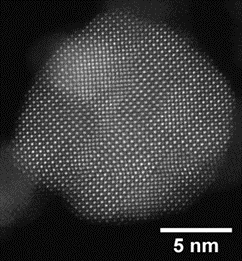Perovskites (ABO3) and spinels (AxB3−xO4) from spray-flame synthesis

Figure 1. HAADF-STEM picture of a LaCoO3 nanoparticle.
A variety of crystallographic/lattice defects can be seen.
Perovskite- and spinel-structured transition-metal-based oxides are promising electrocatalysts for electrochemical water oxidation. Thanks to their flexible crystal and electronic structures together with their chemical versatility, perovskites and spinels have shown the ability to preserve different oxidation states of transition metals and thus to uncover novel oxidation properties while keeping their structural stability. They are currently attractive for multiple heterogeneous catalytic environmental- and energy-related applications like the electrochemical water splitting to produce oxygen and hydrogen. Our institute has experience developing materials such as LaFexCo1–xO3 perovskites [1],[2] and CoxFe3‑xO4 spinels [3]. As both materials systems enable the incorporation/substitution of cations, these structures can be tuned to match the requirements of a desired application. As an example, a HAADF-STEM picture of a 14-nm spray-flame synthesized LaCoO3 particle is presented in Figure 1.
[1] S. Angel, J. Neises, M. Dreyer, K. Friedel-Ortega, M. Behrens, Y. Wang, H. Arandiyan, C. Schulz, H. Wiggers, Spray‐flame synthesis of La(Fe, Co)O3 nano‐perovskites from metal nitrates, AIChE Journal 66 (2019) e16748, doi: 10.1002/aic.16748.
[2] B. Alkan, M. Braun, B. Alkan, J. Landers, S. Salamon, H. Wende, C. Andronescu, C. Schulz. H. Wiggers, Spray‐Flame‐Synthesized LaCo1−xFexO3 Perovskite nanoparticles as electrocatalysts for water and ethanol oxidation, ChemElectroChem 6 (2019) 4266-4274, doi: 10.1002/celc.201900168.
[3] J. Büker, S. Angel, S. Salamon, J. Landers, T. Falk, H. Wende, H. Wiggers, C. Schulz, M. Muhler, B. Peng, Structure–activity correlation in aerobic cyclohexene oxidation and peroxide decomposition over CoxFe3−xO4 spinel oxides, Catalysis Science & Technology, 12 (2022) 3594-3605 doi: 10.1039/d2cy00505k.
High-entropy oxides from spray-flame synthesis
High-entropy oxide (HEO) materials, a novel subset of advanced ceramics in materials science, have garnered significant attention owing to their distinctive composition, exceptional properties, and the intriguing entropy stabilization phenomenon. Departing from traditional oxide materials, HEOs exhibit a unique crystal structure marked by the incorporation of multiple metal cations in nearly equimolar proportions, resulting in heightened thermodynamic stability and configurational entropy. This distinctive composition imparts remarkable mechanical, thermal, and electronic properties, positioning HEOs as highly promising for diverse applications.
The entropy stabilization mechanism in HEOs plays a pivotal role in their unique properties. Beyond a critical temperature, the positive entropy of formation effectively counterbalances an unfavorable enthalpy of formation, resulting in an overall negative Gibbs free energy (ΔGf). This ‘entropy stabilization’ phenomenon distinguishes HEOs and contributes to their exceptional stability, further augmenting their potential for transformative applications in catalysis, energy storage, and electronic devices.
The adoption of spray-flame synthesis emerges as an optimal methodology for HEO fabrication, offering a streamlined and efficient process for their production. This technique facilitates the one-step synthesis of ligand-free mixed metal oxides through gas-phase reactions, thereby minimizing the introduction of impurities associated with conventional methods like solid-state or wet-chemical synthesis. Additionally, spray flame synthesis enables precise control over the compositional ratios of metal cations in HEOs, allowing systematic exploration of equimolar configurations. The inherent versatility of this method not only expedites the synthesis of phase-pure HEOs but also enhances scalability and reproducibility, making it a powerful tool across various scientific and technological domains.

